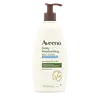What's inside
What's inside
 Key Ingredients
Key Ingredients

 Benefits
Benefits

 Concerns
Concerns

 Ingredients Side-by-side
Ingredients Side-by-side

Water
Skin ConditioningDicaprylyl Ether
EmollientGlycerin
HumectantCaprylic/Capric Triglyceride
MaskingStearic Acid
CleansingAvena Sativa Kernel Flour
AbrasiveCetyl Alcohol
EmollientCetearyl Alcohol
EmollientPhenoxyethanol
PreservativeDimethicone
EmollientCaprylyl Glycol
EmollientCarbomer
Emulsion StabilisingCeteareth-20
CleansingSodium Hydroxide
BufferingChlorphenesin
AntimicrobialSodium Citrate
BufferingCitric Acid
BufferingWater
Skin ConditioningGlycerin
HumectantCaprylic/Capric Triglyceride
MaskingNiacinamide
SmoothingDimethicone
EmollientButylene Glycol
HumectantGlyceryl Stearate
EmollientPEG-100 Stearate
Xylitylglucoside
HumectantAnhydroxylitol
HumectantXylitol
HumectantHyaluronic Acid
HumectantGlyceryl Glucoside
HumectantButyrospermum Parkii Butter
Skin ConditioningCetyl Alcohol
EmollientZea Mays Starch
AbsorbentPanthenol
Skin ConditioningTocopheryl Acetate
AntioxidantPersea Gratissima Oil
Skin ConditioningPrunus Persica Kernel Oil
EmollientLaminaria Digitata Extract
Skin ProtectingCetyl-Pg Hydroxyethyl Palmitamide
Skin ConditioningCeramide EOP
Skin ConditioningCeramide Ns
Skin ConditioningCeramide NP
Skin ConditioningCeramide As
Skin ConditioningCeramide AP
Skin ConditioningHydrolyzed Milk Protein
Skin ConditioningAcrylates/Beheneth-25 Methacrylate Copolymer
Ammonium Acryloyldimethyltaurate/Vp Copolymer
Titanium Dioxide
Cosmetic ColorantArginine
MaskingEthylhexylglycerin
Skin ConditioningPhenoxyethanol
PreservativeSodium Hydroxide
BufferingDisodium EDTA
CI 19140
Cosmetic ColorantCI 42090
Cosmetic ColorantWater, Glycerin, Caprylic/Capric Triglyceride, Niacinamide, Dimethicone, Butylene Glycol, Glyceryl Stearate, PEG-100 Stearate, Xylitylglucoside, Anhydroxylitol, Xylitol, Hyaluronic Acid, Glyceryl Glucoside, Butyrospermum Parkii Butter, Cetyl Alcohol, Zea Mays Starch, Panthenol, Tocopheryl Acetate, Persea Gratissima Oil, Prunus Persica Kernel Oil, Laminaria Digitata Extract, Cetyl-Pg Hydroxyethyl Palmitamide, Ceramide EOP, Ceramide Ns, Ceramide NP, Ceramide As, Ceramide AP, Hydrolyzed Milk Protein, Acrylates/Beheneth-25 Methacrylate Copolymer, Ammonium Acryloyldimethyltaurate/Vp Copolymer, Titanium Dioxide, Arginine, Ethylhexylglycerin, Phenoxyethanol, Sodium Hydroxide, Disodium EDTA, CI 19140, CI 42090
Ingredients Explained
These ingredients are found in both products.
Ingredients higher up in an ingredient list are typically present in a larger amount.
This ingredient is an emollient, solvent, and texture enhancer. It is considered a skin-softener by helping the skin prevent moisture loss.
It helps thicken a product's formula and makes it easier to spread by dissolving clumping compounds.
Caprylic Triglyceride is made by combining glycerin with coconut oil, forming a clear liquid.
While there is an assumption Caprylic Triglyceride can clog pores due to it being derived from coconut oil, there is no research supporting this.
Learn more about Caprylic/Capric TriglycerideCetyl Alcohol is a fatty alcohol. Fatty Alcohols are most often used as an emollient or to thicken a product.
Its main roles are:
Though it has "alcohol" in the name, it is not related to denatured alcohol or ethyl alcohol.
The FDA allows products labeled "alcohol-free" to have fatty alcohols.
Learn more about Cetyl AlcoholDimethicone is a type of synthetic silicone created from natural materials such as quartz.
What it does:
Dimethicone comes in different viscosities:
Depending on the viscosity, dimethicone has different properties.
Ingredients lists don't always show which type is used, so we recommend reaching out to the brand if you have questions about the viscosity.
This ingredient is unlikely to cause irritation because it does not get absorbed into skin. However, people with silicone allergies should be careful about using this ingredient.
Note: Dimethicone may contribute to pilling. This is because it is not oil or water soluble, so pilling may occur when layered with products. When mixed with heavy oils in a formula, the outcome is also quite greasy.
Learn more about DimethiconeGlycerin is already naturally found in your skin. It helps moisturize and protect your skin.
A study from 2016 found glycerin to be more effective as a humectant than AHAs and hyaluronic acid.
As a humectant, it helps the skin stay hydrated by pulling moisture to your skin. The low molecular weight of glycerin allows it to pull moisture into the deeper layers of your skin.
Hydrated skin improves your skin barrier; Your skin barrier helps protect against irritants and bacteria.
Glycerin has also been found to have antimicrobial and antiviral properties. Due to these properties, glycerin is often used in wound and burn treatments.
In cosmetics, glycerin is usually derived from plants such as soybean or palm. However, it can also be sourced from animals, such as tallow or animal fat.
This ingredient is organic, colorless, odorless, and non-toxic.
Glycerin is the name for this ingredient in American English. British English uses Glycerol/Glycerine.
Learn more about GlycerinPhenoxyethanol is a preservative that has germicide, antimicrobial, and aromatic properties. Studies show that phenoxyethanol can prevent microbial growth. By itself, it has a scent that is similar to that of a rose.
It's often used in formulations along with Caprylyl Glycol to preserve the shelf life of products.
Sodium Hydroxide is also known as lye or caustic soda. It is used to adjust the pH of products; many ingredients require a specific pH to be effective.
In small amounts, sodium hydroxide is considered safe to use. However, large amounts may cause chemical burns due to its high alkaline.
Your skin has a natural pH and acid mantle. This acid mantle helps prevent harmful bacteria from breaking through. The acid mantle also helps keep your skin hydrated.
"Alkaline" refers to a high pH level. A low pH level would be considered acidic.
Learn more about Sodium HydroxideWater. It's the most common cosmetic ingredient of all. You'll usually see it at the top of ingredient lists, meaning that it makes up the largest part of the product.
So why is it so popular? Water most often acts as a solvent - this means that it helps dissolve other ingredients into the formulation.
You'll also recognize water as that liquid we all need to stay alive. If you see this, drink a glass of water. Stay hydrated!
Learn more about Water